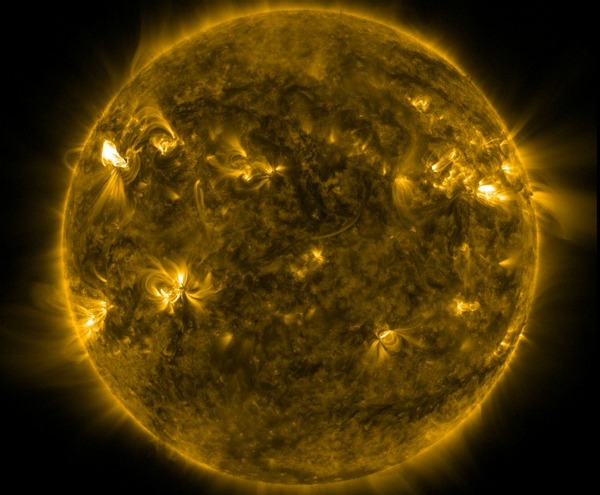Solar Storm Blasted Earth With Mega-Energy Dose

A recent spate of furious eruptions on the surface of the sun hurled a huge amount of heat toward Earth — the biggest dose our planet has received from our closest star in seven years, NASA scientists said.
The March 8 through 10 solar storm shot enough energy toward Earth to power every home in New York City for two years, according to space agency researchers.
Although the influx of solar energy puffed up the atmosphere, increasing drag on low-orbiting satellites, it caused fewer disruptions to electronic infrastructure such as electronic grids than some expected. It also offered plenty of eye candy, sparking dazzling auroras in many places.
"It was a big event, and shows how solar activity can directly affect our planet," Martin Mlynczak of NASA Langley Research Center said in a statement.
The solar eruptions began on March 6, and on March 8 a coronal mass ejection — a wave of charged particles — smashed into Earth's magnetic field.
For the next three days, the upper atmosphere, known as the thermosphere, absorbed 26 billion kilowatt-hours of energy. Infrared radiation from carbon dioxide and nitric oxide, the two most efficient coolants in the thermosphere, radiated 95 percent of that total back into space.
"The thermosphere lit up like a Christmas tree," said James Russell of Virginia's Hampton University.
Get the Space.com Newsletter
Breaking space news, the latest updates on rocket launches, skywatching events and more!
Both Russell and Mlynczak work with SABER, an instrument aboard a NASA satellite. The instrument monitors infrared emissions from Earth’s upper atmosphere, particularly from carbon dioxide and nitric oxide. Both compounds play a key role in the energy balance hundreds of miles above our planet's surface.
Mlynczak said that, despite the impressive numbers, there's no way to harness the incredible amount of energy the sun shot at the Earth. "It’s so diffuse and out of reach high above Earth's surface," he said. And, he added, carbon dioxide and nitric oxide send the majority of the energy back into space.
Although the early March solar storm is ended, the scientists said there is plenty more to come.
"We’re just emerging from a deep solar minimum," Russell said. "The solar cycle is gaining strength with a maximum expected in 2013."
This story was provided by OurAmazingPlanet, a sister site to SPACE.com. Follow OurAmazingPlanet for the latest in Earth science and exploration news on Twitter @OAPlanet and on Facebook.
Join our Space Forums to keep talking space on the latest missions, night sky and more! And if you have a news tip, correction or comment, let us know at: community@space.com.
For the science geek in everyone, Live Science breaks down the stories behind the most interesting news and photos on the Internet, while also digging up fascinating discoveries that hit on a broad range of fields, from dinosaurs and archaeology to wacky physics and astronomy to health and human behavior. If you want to learn something interesting every day, Live Science is the place for you.










